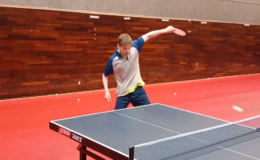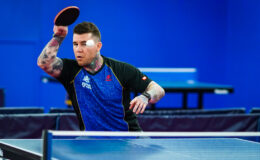 By Larry Hodges, USATT Hall of Famer and Certified National Coach
By Larry Hodges, USATT Hall of Famer and Certified National Coach
These days it seems like everyone’s trying to be like everyone else. That’s a pretty successful way of getting good, if you copy the top players. But many are missing the benefits of doing something different. Give your opponent a different look, at least on some shots, and guess what? He might begin to struggle. This doesn’t mean changing your whole game to some unorthodox mess; it means developing certain “pet shots” that are different than the norm. They give you more variation on certain shots than if you only have “orthodox” shots.
For example, a few years ago penholder Wang Hao and shakehanders Ma Long and Zhang Jike, all from China, showed up on the world scene flipping short serves to their forehands with their backhands (with banana flips, i.e. mini backhand loops over the table with topspin and sidespin), and all three reached #1 in the world. Few had done this before, and now seemingly everyone at the higher levels is doing it. Or check out videos of Dimitrij Ovtcharov of Germany, world #6 and the #1 European, and his unorthodox backhand serve from the middle of the table. Or former world #1 Timo Boll, also of Germany, who often switches to a forehand grip for looping with extreme inside-out sidespin loops.
Some, of course, naturally do something different, by having a non-inverted surface, a different grip (Seemiller grip, or even penhold grip for some, since many aren’t used to playing that), an unorthodox stroke (not usually good unless it’s just as a variation), or even something as simple as being left-handed. But for most players, you’ll want to do something “different” while sticking to your normal shakehands inverted on both sides game. And there are lots of ways. Below are ten examples – and I do all of these on occasion, though less now than when I was an active tournament player and honed these variations by actually using them regularly. Pick out one or two, and give them a try!
- Serve from forehand side. Nearly everyone serves from the backhand corner these days, with a few tomahawk serves from the forehand. Throw in a few forehand pendulum or backhand serves from the forehand side. The surprise factor will often make up for your starting a bit out of position.
- Serve short sidespin to the forehand. So many players serve over and Over and OVER to the middle and backhand it’s almost silly, and when they do serve short to the forehand, it’s a simple backspin ball. Instead, learn to serve short to the forehand with sidespin that pulls the ball toward your forehand, making it awkward for the opponent to return the ball down the line. You can do this with a backhand serve, a reverse pendulum serve, or a forehand tomahawk serve. Or do it with a regular forehand pendulum serve.
- Slow, spinny loop. Most people these days loop either hard or harder. Try letting the ball drop a bit more, and go for a super-spinny slow one. If it goes deep, it’ll drive blockers crazy. If it lands short, it’ll drive counter-loopers crazy.
- Dead loop. Fake spin, and instead give a dead loop. You sell this by using an exaggerated follow-through right after contact (including a big wrist snap), making it seem spinny.
- Dead push. Push without spin, but with an exaggerated follow through to fake spin.
- Sidespin push. Come across the ball as you push. This is especially easy on the backhand, with a right-to-left motion (for righties), with the ball breaking to the right. It’s especially effective wide to the right, breaking into a righty’s opponent’s backhand.
- Ginzo push. Most players push to keep the ball in play. Thrown in a few super-ginzo (i.e. extremely heavy) pushes, and watch opponents struggle. It’s easier if you take the ball a little later for this, but advanced players can do this quick off the bounce.
- Dead block. Block it dead, chop block, sidespin block – these will frustrate many opponents and set you up for a conventional attack. They are especially effective and easy on the backhand side.
- Countering change-of-pace. Rather than bang every ball in a fast counter-hitting rally, sometimes hit one soft. Either keep it low and short to the net, or deep on the table.
- Flatter flip. Most players flip short balls with topspin. (It’s called a flick in Europe.) Sometimes try a flatter one. Hit it a bit softer since you don’t have topspin to pull it down, but not too soft. (Recently I’ve seen a number of top players experimenting with this variation.)



